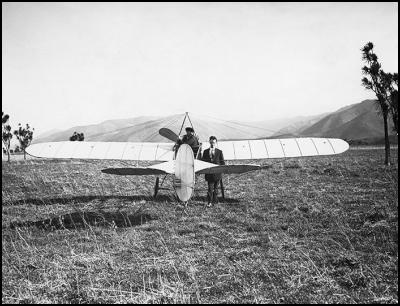Experimental Flights of the Fisher Monoplane
Experimental Flights of the Fisher
Monoplane

The Film Archive commemorates the first flight of kiwi aviation pioneer Percy Fisher’s monoplane 100 years ago. On June 21 1913 Fisher successfully launched his monoplane at Hurunui-O-Rangi Flat, near Gladstone, in the Wairarapa. Join us and Fisher’s descendants for a free screening of the newly restored footage of this first flight.
David Percival Fisher (1882-1941), the Wellington-born engineer and inventor, had been building and refining his monoplane since June 1911. The Fisher Monoplane, which was 7.62 metres long and weighed 196.9kg, was constructed out of wood, cross-wire bracing, and varnished Japanese silk. Fisher spent much time trialling his monoplane, but by the successful flight in 1913 had relinquished pilot duties to Reginald White.
The Fisher Monoplane’s first flight was caught on film by local film maker Charlie Barton. To capitalize on public interest, Barton released his three-minute film, Experimental Flights of the Fisher Monoplane, at the People’s Picture Palace in Wellington in July 1913. Standing room only audiences applauded the local effort and the film was shown throughout the country.
Along with the film screening, the evening’s festivities at the Film Archive will include a talk by Fisher’s great grandson, Paul Maxim. Maxim will speak about Percy Fisher, the man, and the specifics of his monoplane design. He will also have with him a portion of the Fisher Monoplane’s tail - the only part of the original aircraft remaining today.
Maxim’s talk will be followed by a presentation by NZFA Film Conservator Reiner Schoenbrunn, who worked to restore the film. The film is significant because it is the only surviving footage of early aviation in New Zealand.
As the 1913 master negative is presumed lost, Schoenbrunn assembled his restored version from the best-quality 35mm nitrate duplicate positive available of the film.
“Unfortunately conventional film to film duplication causes loss in image quality,” says Schoenbrunn. “In this case it was so bad that finer details of the plane’s engine or undercarriage were filled in dark, and lighter areas - such as people’s faces - appeared mostly pale and featureless. This was the picture quality audiences have seen for the last forty years.”
Schoenbrunn was able to improve the appearance of this source footage by scanning it at highest resolution currently practical, creating a digital file that was then graded frame by frame. Great care was taken to retain all details relevant to the plane’s construction, the people operating it, and the surrounding location.
“In some tricky cases the image was split digitally and each half was graded to best possible values, a process not easily possible in pre-digital days,” says Schoenbrunn.
See the restored footage for yourself at the Experimental Flights of the Fisher Monoplane film presentation, 6pm, Friday 21 June. At The Film Archive, 84 Taranaki St, Wellington.
The monoplane was taken to Carterton
several weeks later to resume trials. Although the monoplane
had made several long “hops” at Pigeon Bush, it was
obvious that the location was too windy to achieve safe
flight. Both men had flown at Pigeon Bush and talked of
feeling the effects of heavy landings and smashes for weeks
afterwards.
ends


 Water Safety New Zealand: Don’t Drink And Dive
Water Safety New Zealand: Don’t Drink And Dive NZ Olympic Committee: Lydia Ko Awarded Lonsdale Cup For 2024
NZ Olympic Committee: Lydia Ko Awarded Lonsdale Cup For 2024 BNZ Breakers: BNZ Breakers Beaten By Tasmania Jackjumpers On Christmas Night
BNZ Breakers: BNZ Breakers Beaten By Tasmania Jackjumpers On Christmas Night Te Whatu Ora Health NZ: Health Warning – Unsafe Recreational Water Quality At Roto Kohatu Reserve At Lake Rua
Te Whatu Ora Health NZ: Health Warning – Unsafe Recreational Water Quality At Roto Kohatu Reserve At Lake Rua Shearing Sports NZ: Shearing Them Around - 11 Shearing Records In 2024
Shearing Sports NZ: Shearing Them Around - 11 Shearing Records In 2024 The New Zealand Retro: Special End Of Year Retro Chart Show On Independent Radio Stations
The New Zealand Retro: Special End Of Year Retro Chart Show On Independent Radio Stations